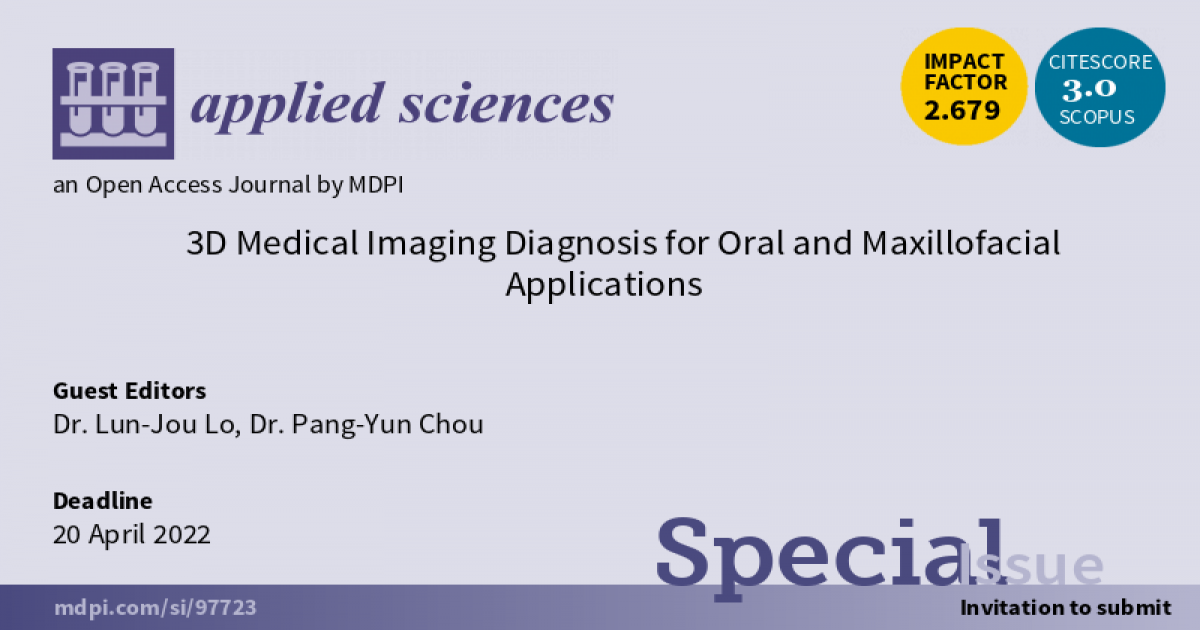3D Medical Imaging Diagnosis for Oral and Maxillofacial Applications
A special issue of Applied Sciences (ISSN 2076-3417). This special issue belongs to the section "Applied Biosciences and Bioengineering".
Deadline for manuscript submissions: closed (20 April 2022) | Viewed by 7027

Special Issue Editors
Interests: cleft lip and palate; craniofacial deformity; orthognathic surgery; facial cosmetic surgery
Interests: 3D printing; CAD/CAM; cleft lip/palate; orthognathic surgery
Special Issues, Collections and Topics in MDPI journals
Special Issue Information
Dear Colleagues,
We are pleased to announce a new Special Issue that is open to receiving potential manuscripts in the journal Applied Sciences, with the theme “3D Medical Imaging Diagnosis for Oral and Maxillofacial Applications”.
The application of 3D medical imaging has become a popular and advanced technique, currently used to assist in diagnosing oral diseases and in maxillofacial surgery, such as in the field of head and neck reconstruction, congenital craniofacial anomaly, traumatic deformity, orthognathic surgery, and so on. By using 3D technology in imaging modality with virtual surgical planning, one can reduce the operation time, avoid post-operative complications, and improve surgical accuracy and outcome, as well as achieve the patient’s satisfaction. Furthermore, 3D printing and model fabrication can be applied to patient consultations or the production of patient-specific implants.
The scope of the Special Issue is to pursue more information regarding precision medicine with the application of 3D imaging in oral and maxillofacial surgery. We look forward to receiving your studies reporting the invaluable experiences of 3D technology applications for this Special Issue. With your contributions, we can create the innovative, revolutionary future together.
Dr. Lun-Jou Lo
Dr. Pang-Yun Chou
Guest Editors
Manuscript Submission Information
Manuscripts should be submitted online at www.mdpi.com by registering and logging in to this website. Once you are registered, click here to go to the submission form. Manuscripts can be submitted until the deadline. All submissions that pass pre-check are peer-reviewed. Accepted papers will be published continuously in the journal (as soon as accepted) and will be listed together on the special issue website. Research articles, review articles as well as short communications are invited. For planned papers, a title and short abstract (about 100 words) can be sent to the Editorial Office for announcement on this website.
Submitted manuscripts should not have been published previously, nor be under consideration for publication elsewhere (except conference proceedings papers). All manuscripts are thoroughly refereed through a single-blind peer-review process. A guide for authors and other relevant information for submission of manuscripts is available on the Instructions for Authors page. Applied Sciences is an international peer-reviewed open access semimonthly journal published by MDPI.
Please visit the Instructions for Authors page before submitting a manuscript. The Article Processing Charge (APC) for publication in this open access journal is 2400 CHF (Swiss Francs). Submitted papers should be well formatted and use good English. Authors may use MDPI's English editing service prior to publication or during author revisions.
Keywords
- virtual surgical planning
- 3D imaging
- 3D printing
- patient-specific implants
- oral maxillofacial surgery






